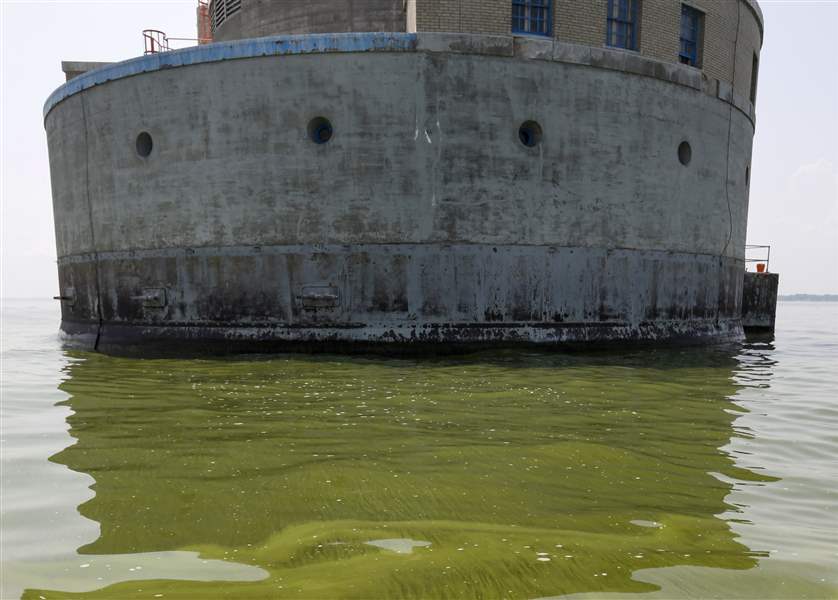
Lake Erie Foundation seeks to join landmark lawsuit
8/14/2018
In 2014 photo algae is visible in Lake Erie near the Toledo water intake crib.
The Blade
Buy This Image
The 500-member Lake Erie Foundation is the latest group trying to become co-plaintiffs in a lawsuit calling upon Senior U.S. District Judge James G. Carr to order the most comprehensive cleanup strategy for western Lake Erie.
The foundation is a nonprofit formed in 2016 when Lake Erie Waterkeeper and the Lake Erie Improvement Association were combined.
In a document filed Tuesday in U.S. District Court, the group joined the cities of Toledo and Oregon in making a near-identical request to become co-plaintiffs in a lawsuit two groups — the Environmental Law & Policy Center and Advocates for a Clean Lake Erie — brought against the U.S. Environmental Protection Agency in 2017.
The latter two groups have contended all along that the U.S. EPA has not been living up to requirements for Lake Erie that were established by Congress under the federal Clean Water Act back in 1972.
Plaintiff and would-be plaintiffs contend the federal Clean Water Act requires a clean up strategy based around a “total maximum daily load,” or TMDL program for phosphorus, the nutrient most closely associated with algal growth.
Phosphorus is found in anything from raw human waste to animal manure and commercial fertilizers. A TMDL is envisioned as the most restrictive of all cleanup strategies.
The two groups which brought the lawsuit first argued the federal agency was wrong to let the Ohio EPA dodge an impairment designation for the lake’s open water.
Once the federal and state EPA reversed course on that issue earlier this year, the focus moved on to the subsequent cleanup strategy. ELPC and ACLE argue the law requires the creation of regional phosphorous limitations for Lake Erie, which is far more site-specific and potentially more onerous to large agricultural operations than anything attempted so far.
The U.S. Department of Justice, on behalf of the U.S. EPA, argues such a program is unnecessary.
The next court hearing is Aug. 21.
In its filing, the Lake Erie Foundation said it “has spent significant time and resources researching solutions to Lake Erie’s HABs [harmful algal blooms] and researching methods that have been used in other parts of the United States.”
“This research has demonstrated to LEF that establishing a Total Maximum Daily Load for Lake Erie is necessary to successfully address the HAB problem in Lake Erie,” the foundation’s attorney, Megan M. Hunter of Akron wrote. “LEF’s members and Lake Erie cannot afford to wait for piecemeal litigation to take the place of urgently needed agency action to establish a TMDL for western Lake Erie.”
Foundation members further argue the U.S. EPA and the Ohio EPA “have each pointed to the other as justification for the abrogation of their respective responsibilities” in establishing a TMDL for Lake Erie and that the two agencies have been “stuck in this pattern of deferral” as a delay tactic.
The Lake Erie Foundation cites examples from the Chesapeake Bay, the nation’s largest ecosystem under a TMDL. It has sponsored talks by Chesapeake Bay speakers in northwest Ohio on several occasions.
In a news release distributed Tuesday afternoon, the foundation said that part of the country went through “nearly 30 years of failed efforts of the multi-jurisdictional Chesapeake Bay agreements from 1983 until 2010.”
“It was only when the TMDL was established in 2010 that progress in addressing the problems began. Today, one will find a greatly improved Chesapeake Bay with the return of the oyster and crab businesses and healthier bay waters,” the group said, adding that Lake Erie is “experiencing this same type of multijurisdictional failure” today.
The U.S. EPA has declined comment on the case, citing its longstanding policy against speaking publicly about pending court cases.
The judge, in a 25-page order last April, accused the U.S. EPA and the Ohio EPA of botching the Lake Erie impairment controversy and, at one point, went so far as to say the federal agency demonstrated a “whiff of bad faith.”
Contact Tom Henry at thenry@theblade.com, 419-724-6079, or via Twitter @ecowriterohio.